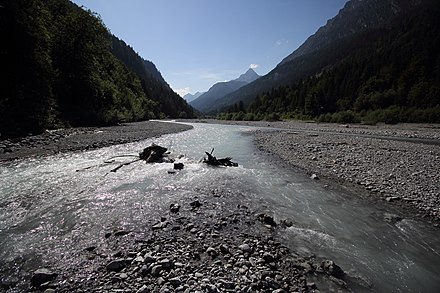
An alluvial river is one in which the bed and banks are made up of mobile sediment and/or soil. Alluvial rivers are self-formed, meaning that their channels are shaped by the magnitude and frequency of the floods that they experience, and the ability of these floods to erode, deposit, and transport sediment. For this reason, alluvial rivers can assume a number of forms based on the properties of their banks; the flows they experience; the local riparian ecology; and the amount, size, and type of sediment that they carry.[1]
At a smaller spatial scale and shorter time scale, the patterns of water movement, from events such as seasonal flooding, create different patches of soils that range from aerobic to anaerobic and have differing nutrients and decomposition rates and dynamics. When looking at larger spatial scales, the topographic features have been created by glacial events, such as glaciation and deglaciation, changes in sea-levels, tectonic movements, and other events that occur over longer time scales. These short and long-term scales together determine the patterns and characteristics of alluvial rivers. These rivers also consist of certain topographic features that include hillslopes at the formation of the valley's sides, terraces, remains of old floodplains at higher elevations than the floodplain that is currently active, levees that are natural, meander scrolls, natural drainage channels, and floodplains that are temporary, as well as permanent.[2]
- ^ Leopold, Luna B.; Wolman, M. G.; Miller, J. P. (1964). Fluvial Processes in Geomorphology. San Francisco: W.H. Freeman and Co.
- ^ Ward, J. V.; Stanford, J. A. (September 1995). "Ecological connectivity in alluvial river ecosystems and its disruption by flow regulation". Regulated Rivers: Research & Management. 11 (1): 105–119. doi:10.1002/rrr.3450110109.